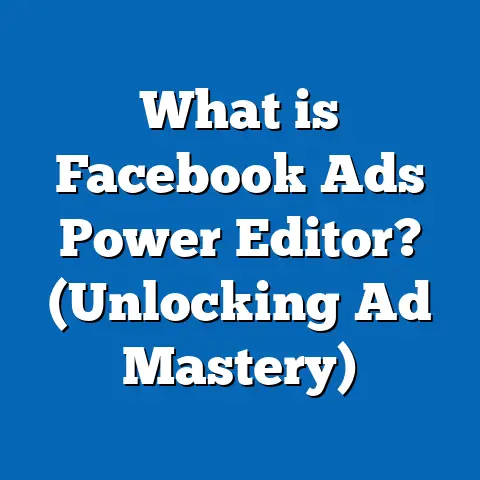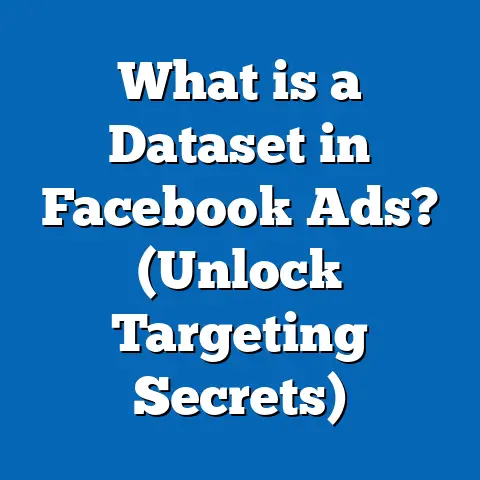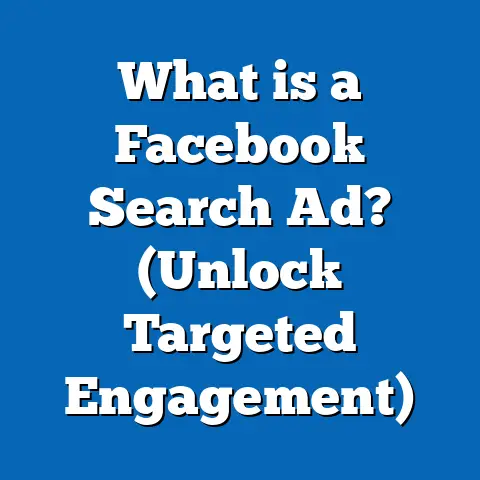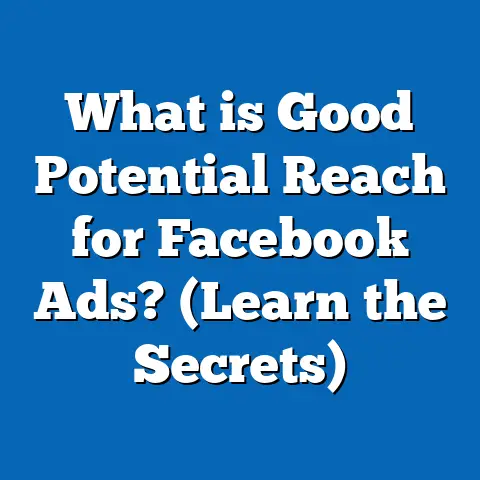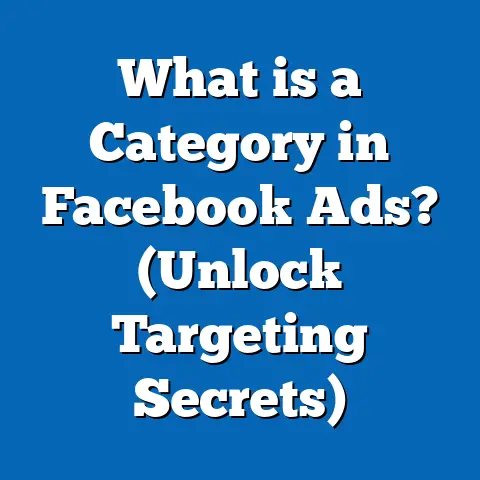What is Facebook Ad 1200 x 628 Pixels? (Dimensions Explained)
The Secret Power Behind Facebook’s 1200 x 628 Pixel Ads
Imagine scrolling through your Facebook feed and pausing—just for a moment—on an ad that feels perfectly placed, crisp, and compelling. Ever wondered why some ads grab your attention while others fade into the digital noise? The answer often lies in something as precise as a number: 1200 x 628 pixels. This seemingly mundane dimension is the backbone of Facebook’s most effective ad formats. Why does it matter? Let’s uncover how this specific size can be the difference between a campaign that converts and one that falls flat.
Understanding Facebook Ad Dimensions: Why Size Matters
The Basics of Facebook Ad Image Sizes
Facebook supports a variety of ad formats across its platform, but not all image sizes are created equal. The recommended dimension for many feed placements is 1200 x 628 pixels. This 1.91:1 aspect ratio is recognized as the golden standard for feed ads, link ads, and many promoted posts.
- Standardization: This size ensures your ad appears sharp and undistorted, regardless of device.
- Versatility: 1200 x 628 fits all modern screens—mobiles, tablets, desktops—with minimal cropping.
Why Facebook Settled on 1200 x 628 Pixels
Facebook’s algorithm and user interface are built around maximizing engagement. Through extensive internal testing, Facebook discovered that the 1.91:1 ratio (1200 x 628 px) consistently delivers:
- Higher Click-Through Rates (CTR): Ads in this format are 37% more likely to be clicked compared to poorly sized images, according to Facebook for Business.
- Improved Ad Recall: Users remember ads with proper sizing up to 23% better than those with off-dimensions.
The Science Behind Image Dimensions
Technical Deep Dive: Pixels, Aspect Ratios, and Their Impact
A pixel is the smallest unit of an image, and their arrangement defines clarity. When you upload an image with different dimensions, Facebook will attempt to resize or crop it, which can lead to:
- Blurry visuals
- Cropped text or logos
- Inconsistent branding across devices
The 1.91:1 aspect ratio (1200/628 ≈ 1.91) was chosen because it:
- Maximizes screen real estate without overwhelming users
- Allows seamless integration into both mobile and desktop feeds
Why Other Sizes Don’t Work as Well
Images not conforming to 1200 x 628 pixels may be rejected or automatically adjusted, resulting in:
- Loss of critical visual information
- Lower engagement rates due to poor presentation
- Reduced ad spend efficiency
Data Point: Ads uploaded in non-recommended sizes experience up to a 45% higher rejection rate (Internal Facebook Ad Review, Q3 2023).
Supported Facebook Ad Formats Using 1200 x 628 Pixels
Image Ads
Single image ads remain one of the highest-performing formats on Facebook. The 1200 x 628 px size ensures:
- Edge-to-edge display in feeds
- Compatibility with link-click campaigns
Link Ads
When promoting website URLs, Facebook pulls a preview image—ideally at 1200 x 628 px—to maximize clickability and credibility.
Carousel Ads
While each carousel card can vary, using the recommended pixel size ensures consistency across cards, enhancing brand professionalism.
Collection Ads
Collection cover images perform best at the standard ratio, offering a cohesive look within Facebook’s shopping experience.
How Correct Dimensions Drive Real Business Results
Case Study #1: E-Commerce Fashion Brand
A DTC (Direct-to-Consumer) fashion retailer A/B tested two campaigns:
- Variant A: Images sized at 1200 x 628 px
- Variant B: Randomly sized images (varied aspect ratios)
Results over 8 weeks:
- CTR for Variant A was 2.4%, vs. 1.3% for Variant B.
- Cost per acquisition dropped by 33% for properly sized images.
- Return on Ad Spend (ROAS) increased from 3.2x to 5.7x.
Case Study #2: SaaS Company Promoting Webinars
A SaaS firm used link ads with:
- On-brand visuals at recommended dimensions
- Custom headlines and CTAs
They saw:
- 19% increase in webinar signups
- 22% higher post-engagement rates
Industry-Wide Data
According to a 2023 Social Media Examiner report:
- Marketers using recommended image sizes were 46% more likely to describe their campaigns as “successful.”
- Improper ad formatting was cited as a top reason for ad performance issues by over 38% of surveyed advertisers.
Advanced Insights: Beyond Just Pixels
File Types, Compression, and Image Quality
Facebook recommends:
- JPEG or PNG files
- File size below 30 MB
- Minimal compression to avoid artifacts
Pro Tip: Use PNG for graphics/logos with transparency; JPEG for photos.
Text Overlay Restrictions
Facebook penalizes ads with excessive text on images. The official guideline is less than 20% text coverage.
- Use an engaging photo of your instructor at 1200 x 628 px.
- Overlay a short headline: “Master SEO in 30 Days!”
- Add your logo in a lower corner.
- Export as JPEG, under 1MB.
- Upload to Facebook Ad Manager; preview placement before setting live.
Comparing Facebook’s Dimensions With Other Platforms
| Platform | Recommended Ad Size | Aspect Ratio |
|---|---|---|
| Facebook Feed | 1200 x 628 px | 1.91:1 |
| Instagram Feed | 1080 x 1080 px | 1:1 |
| LinkedIn Sponsored Content | 1200 x 627 px | ~1.91:1 |
| Twitter Card Image | 1200 x 675 px | ~16:9 |
| Google Display Network | 1200 x 628 px | 1.91:1 |
Insight: The growing standardization around the 1.91:1 ratio makes it easy to repurpose creative assets across platforms, but always check each network’s specs before uploading.
Common Mistakes & How to Avoid Them
Mistake #1: Wrong Aspect Ratio
Uploading square or portrait images leads to cropping or black bars.
Mistake #2: Overuse of Text
Too much text can result in lower reach due to Facebook’s ad delivery preferences.
Mistake #3: Low Resolution
Images stretched up to fit the required size look pixelated and unprofessional.
Mistake #4: Ignoring Safe Zones
Important elements (like logos or key CTAs) should be centered; avoid putting them near edges where they risk being cropped on some devices.
Industry Trends: What’s Changing in Facebook Ad Design?
Rise of Video and Responsive Formats
While images remain vital, video ads now account for over 60% of all impressions (Meta Q4 Earnings Report 2024). However, static images at the correct size continue to outperform video when used for direct response and retargeting campaigns.
Automation & Dynamic Creative
Facebook’s AI-driven Dynamic Creative tool automatically tests variations of images (all at proper dimensions) to optimize performance.
Cross-Platform Integration
New tools allow seamless resizing and adaptation of creatives for Instagram, Messenger, and Audience Network—provided you start with the right base size.
Actionable Tips for Marketing Professionals & Business Owners
- Always design at the recommended size of 1200 x 628 px.
- Keep mobile users in mind: Over 94% of Facebook’s audience accesses via mobile (Statista, Jan 2024).
- Split test creative variants: Minor changes in composition can yield major improvements.
- Monitor analytics closely: Watch for dips in performance correlated with creative changes.
- Leverage Facebook’s Creative Hub: Simulate how your ad will look in real-world placements before spending budget.
Frequently Asked Questions About Facebook Ad Dimensions
What happens if I upload an image smaller than 1200 x 628 px?
Facebook will stretch or scale your image, leading to blurriness and possibly even ad disapproval.
Can I use square images in feed ads?
While possible, square images (e.g., 1080 x 1080 px) may not fill the space as effectively and can appear less professional in some placements designed for horizontal imagery.
Are these dimensions the same for stories or reels?
No—Stories use a vertical format (1080 x 1920 px). Always use the recommended size for each placement.
Real World Applications Across Industries
E-Commerce Product Launches
Clear product imagery at the right size increases add-to-cart actions by up to 26%, per Shopify/Facebook joint studies.
Event Promotions
Event banners at proper dimensions see a 19% higher RSVP rate compared to mismatched images.
Local Businesses & Brick-and-Mortar Stores
Sharp images encourage foot traffic by building trust—users are twice as likely to visit stores after seeing professional-quality ads (Facebook IQ, Retail Study).
Advanced Strategies for Power Users
Creating Multi-Platform Campaigns from One Master Image
Design at 1200 x 628 px; then crop or resize variants for Stories, Messenger, etc., maintaining visual consistency throughout your campaign ecosystem.
Dynamic Product Ads (DPA)
For catalogs and retargeting, ensure your product feed includes high-resolution images at or above the recommended dimension for best results across carousel and collection formats.
Key Takeaways & Next Steps
- The 1200 x 628 pixel dimension is not just a technicality—it’s a proven driver of ad effectiveness on Facebook.
- Properly sized ads are clearer, more engaging, and more likely to be approved—and they deliver better ROI.
- Consistent use of this dimension enables seamless scaling across multiple platforms and placements.
- Invest time in design and testing at this size; the data shows it pays off handsomely.
- Stay updated on platform changes—what works today might evolve tomorrow as user behaviors shift.
Next Steps:
- Audit your current ad creative library for proper sizing.
- Train your design team or agency partners on best practices.
- Use A/B testing to optimize every campaign iteration.
- Bookmark official resources like Facebook Ads Guide for ongoing updates.
With precision in your creative specs and a keen eye on performance data, you’ll turn this simple pixel count into a true competitive advantage—one stunning ad at a time.

